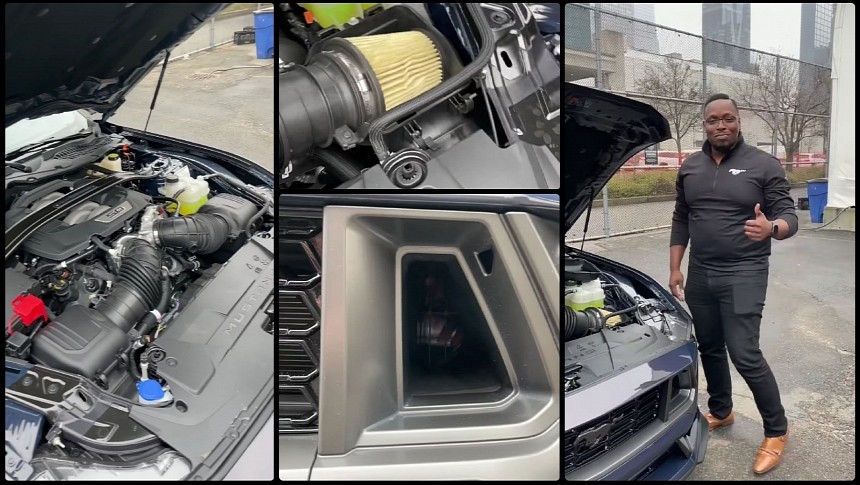It's more sensible to daily a four-cylinder 'Stang for the fuel economy, but on the other hand, the 2.3-liter EcoBoost doesn't hold a candle to the exuberant nature of the 5.0-liter Coyote. Although redesigned for the seventh-generation Mustang with an emphasis on emissions regulations, the EcoBoost pales in comparison to the upgraded Coyote.
The MPC in MPC 2.3-liter EcoBoost stands for Modular Power Cylinder, in turn referring to optimized components shared by a family of engines. The 5.0-liter Coyote, on the other hand, is dubbed Gen IV because it boasts dual air intakes that channel air to a couple of air filters, then to a couple of throttle bodies. The featured clip is our best look yet under the hood of the 2024 model year Mustang with the new eight-cylinder lump.
Fed with air by the nostril-like intake ducts flanking the front grille, the Gen IV uses 80-millimeter throttle bodies instead of a single 87-millimeter unit for the Gen III in the Mach 1 and Shelby GT350. More airflow means bigger bangs, with each throttle body feeding its respective bank of cylinders. Ford also switched from the molded plastic oil pan of the F-150 to a steel oil pan for this application, which also features revised cams.
The 5.0L Ti-VCT V8 continues to employ dual injection. As a rule of thumb, port injection is good for low engine speeds and direct injection for higher engine speeds. The port injection system also eliminates any carbon buildup on the intake valves, an issue that's very common in engines that rely solely on direct injection.
Dark Horse customers are further treated to connecting rods from the 5.2-liter Predator V8 of the Shelby GT500. As opposed to the auto-only EcoBoost, the Coyote is available with both a manual and Ford's trademark 10-speed automatic. There is, however, a big difference between the GT- and Dark Horse-spec transmissions.
Getrag supplies the manual in the GT, whereas Tremec supplies the higher-quality transmission in the Dark Horse. The final drive ranges between 3.31:1 as standard for the GT and 3.73:1 with the Torsen rear differential.
Pretty much a replacement for the Mach 1 from the previous generation, the Dark Horse is the ultimate 'Stang for the 2024 model year. It belts out a massive 500 horsepower, which is 100 ponies for every liter of displacement, and 418 pound-feet (567 Nm) of torque.
Lower down the spectrum, the GT with the optional active-valve performance exhaust features the same peak torque rating and 486 horsepower. That's one more than Chrysler's 392 HEMI, which is a different animal in terms of design due to its cam-in-block architecture.
The GT makes a respectable 480 horsepower and 415 pound-feet (563 Nm). And finally, the MPC 2.3-liter EcoBoost is good for 315 horsepower and 350 pound-feet (475 Nm) on full song with premium-grade fuel.
Fed with air by the nostril-like intake ducts flanking the front grille, the Gen IV uses 80-millimeter throttle bodies instead of a single 87-millimeter unit for the Gen III in the Mach 1 and Shelby GT350. More airflow means bigger bangs, with each throttle body feeding its respective bank of cylinders. Ford also switched from the molded plastic oil pan of the F-150 to a steel oil pan for this application, which also features revised cams.
The 5.0L Ti-VCT V8 continues to employ dual injection. As a rule of thumb, port injection is good for low engine speeds and direct injection for higher engine speeds. The port injection system also eliminates any carbon buildup on the intake valves, an issue that's very common in engines that rely solely on direct injection.
Dark Horse customers are further treated to connecting rods from the 5.2-liter Predator V8 of the Shelby GT500. As opposed to the auto-only EcoBoost, the Coyote is available with both a manual and Ford's trademark 10-speed automatic. There is, however, a big difference between the GT- and Dark Horse-spec transmissions.
Getrag supplies the manual in the GT, whereas Tremec supplies the higher-quality transmission in the Dark Horse. The final drive ranges between 3.31:1 as standard for the GT and 3.73:1 with the Torsen rear differential.
Pretty much a replacement for the Mach 1 from the previous generation, the Dark Horse is the ultimate 'Stang for the 2024 model year. It belts out a massive 500 horsepower, which is 100 ponies for every liter of displacement, and 418 pound-feet (567 Nm) of torque.
Lower down the spectrum, the GT with the optional active-valve performance exhaust features the same peak torque rating and 486 horsepower. That's one more than Chrysler's 392 HEMI, which is a different animal in terms of design due to its cam-in-block architecture.
The GT makes a respectable 480 horsepower and 415 pound-feet (563 Nm). And finally, the MPC 2.3-liter EcoBoost is good for 315 horsepower and 350 pound-feet (475 Nm) on full song with premium-grade fuel.











